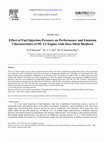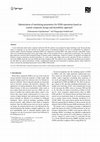Papers by Vemulapalli Chittaranjan das

Biofuels, 2016
The use of diesel engines day by day increased because of their low fuel consumption and high eff... more The use of diesel engines day by day increased because of their low fuel consumption and high efficiencies. Several attempts were made for search of alternative fuels due to increased environmental pollution and exhaustion of conventional fossil fuels and succeeded in the development of Biodiesel as an alternative fuel. An attempt was made on DI-CI engine using shea olein methyl ester blended with diesel in various proportions to study the engine performance and emissions at different injection pressures. The tests were conducted at constant load at different injection pressures (190, 200, 210, 220, 230 bars). In the present work performance characteristics like Brake thermal efficiency, Specific fuel consumption, exhaust gas temperature and emission characteristics like CO, NO X , HC had been investigated. From the results it is observed that 210 bar injection pressure causes better performance and improved emission characteristics, for all the fuel blends.

Journal of Mechanical Science and Technology, 2014
A novel aluminium metal matrix composite reinforced with SiC particles were prepared by liquid me... more A novel aluminium metal matrix composite reinforced with SiC particles were prepared by liquid metallurgy route. Recent developments in composites are not only focused on the improvement of mechanical properties, but also on machinability for difficult-tomachine shapes. Electrical discharge machining (EDM) was employed to machine MMC with copper electrode. using EDM. Experiments were conducted using pulse current, gap voltage, pulse on time and pulse off time as typical process parameters. The experiment plan adopts face centered central composite design of response surface methodology. Analysis of variance was applied to investigate the influence of process parameters and their interactions viz., pulse current, gap voltage, pulse on time and pulse off time on material removal rate (MRR), electrode wear ratio (EWR) and surface roughness (SR). The objective was to identify the significant process parameters that affect the output characteristics. Further a mathematical model has been formulated by applying response surface method in order to estimate the machining characteristics such as MRR, EWR and SR.

Materials Science Forum
Dissimilar joining of high strength tensile steels are joined using laser beam welding. The selec... more Dissimilar joining of high strength tensile steels are joined using laser beam welding. The selection of the welding conditions for joining of dissimilar materials is highly required to satisfy the quality of the joints. In the present investigation, optimization technique were used to determine the optimal welding conditions. Initially welding conditions were optimized for weld geometry and formation of different zones in the weldment. The metallurgical and mechanical properties of the welds are greatly influenced by the geometry of the welds. The surface response methodology design is carried out for the experimental design by the development of regression equations. Analysis of variance (ANOVA) was used to check the validity of the model. The output of the welding conditions were compared with the predicted values to identify the accuracy of the model. The obtained results from response surface methodology were compared with the experimental results and validated.

Materials Science Forum
Nickel based super alloy Inconel 718 is widely used in aerospace and power generation industries.... more Nickel based super alloy Inconel 718 is widely used in aerospace and power generation industries. The dissimilar joining of high strength tensile steel to Inconel 718 was joined using TIG welding. The welding current and travel speed parameters were varied to identify the suitable welding conditions for achieving highest joint strength. Microstructural characterization of the weldments were evaluated by using optical, scanning electron microscope and energy dispersive spectroscopy analysis. The fracture surfaces of the tensile tested joints were investigated under scanning electron microscope to reveal the mode of fracture and its influence on the performance of the joints. Microhardness and tensile tests were conducted to evaluate mechanical properties of the joints. The microstructure evolution revealed that the formation of precipitates at the fusion boundary between the weld zone and Inconel 718 alloy. The hardness of the fusion boundary area id higher than the base metal and fu...
Transactions of the Indian Institute of Metals
Transactions of the Indian Institute of Metals

Uploads
Papers by Vemulapalli Chittaranjan das